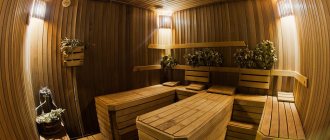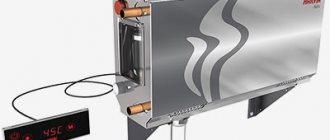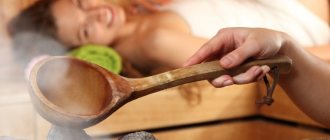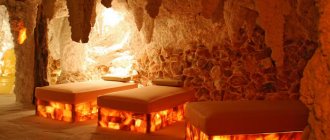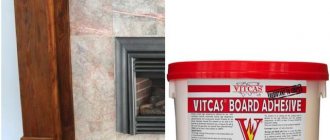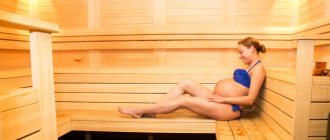For many centuries, hammam has been a favorite pastime for eastern residents. But in the last few decades, the Turkish bath has become popular in Russia, thanks to its low, gentle air temperature and pleasant procedures. But many people still look at the oriental steam room with apprehension: what exactly are the health benefits and harms of a Turkish bath? Who should not visit it, and how should a vacation actually take place there? We will be happy to answer you!
Is it a Turkish bath?...
Quite a serious question. The fact is that today in Russia the bath business is, of course, developed, but to what extent? As it turns out, those who have personally visited a real Turkish bath say that local hammams resemble it only in appearance - but not in sensation. Absolutely wrong humidity, temperature and special means. And not the same effect at all.
Is it worth saying then how dangerous the impact of such a “hamam” on health can be? After all, the Turks have been developing their bath tradition for centuries, selecting the optimal temperature and humidity conditions down to the degree, and carefully observing the necessary sequence of all procedures. And therefore all this had a positive effect on health. And a failure in any technology leads to other consequences.
Moreover, modern hammams in Russia offer three modes of procedures at once: something like a sauna with dry and hot air, a supposedly Russian bath with steam and an air temperature of up to 100°C, and a “Turkish” one, with heat up to 60°C and humidity up to 100%, which is also wrong. But all this is proudly called “hammam”.
And finally, today an innovation such as “hamam-plus” is becoming popular. This is the same Turkish bath with marble on the walls, but in which a special cable is used to warm the walls, beds and floor, providing up to 70°C instead of the required 45°C, and dry “Russian” steam.
It’s like combining two in one: both a hammam and a Russian bathhouse. But such an invention is far from a real Turkish steam room, and staying in it can really undermine your health. But an inexperienced person will be sure that he ended up in a hammam!
So let's take a closer look at what a real Turkish bath actually is and what to expect from it.
How often can you visit the hammam?
The optimal number of visits to procedures in the Turkish hammam is considered to be 2-3 times a week. The healing effect will be noticeable even if you go to the Turkish bath only once a week. But if you attend procedures more than three times a week, you can get harm instead of benefit. It is not recommended to steam more often as this can lead to depression of the nervous system and dehydration.
In Turkey itself, hammams are extremely popular. In Istanbul alone there are more than a hundred of them; in the provinces they can be found in even the most remote village. In some places, bathhouses from 200-300 years ago have been preserved. The procedure of washing in hamams has been used in the Middle East for more than a thousand years.
It is difficult to determine the optimal amount of time spent in the hammam in one session. It can be argued that if you follow the Turkish technology, the bath is useful for 15-45 minutes. However, this issue has not been studied anywhere; according to reviews from frequent guests of hammams, you can sit in the steam room for more than an hour without harm to your health. At the same time, it is necessary to constantly monitor your well-being.
Hamam: a look from the inside
Hamam is the most moisture-rich bathhouse existing in the world. Normal humidity here is considered to be in the range of 80-100%, and this is at a temperature of only 40-45°C.
A real Turkish hammam is a separate building with six rooms: a locker room, a relaxation room, a steam room, a washing room, a massage room and a swimming pool. It is customary to go out of the steam room into the pool, where you first need to swim in hot water, then at a lower temperature, in order to gradually cool down the hot body without any stress on the blood vessels. Of course, this is not Russian fun in the form of diving into a snowdrift after a good broom.
Interestingly, the hammam did not originate in Turkey, but in Rome, where the baths were thermal. But it is worth noting separately the special interior of a true Turkish bath: domed ceilings allow drops of condensation to easily roll onto the floor and evaporate there. And the beautiful stone mosaic in the decoration evenly absorbs thermal radiation and releases it gently. By the way, initially, more useful marble was used in such baths, and therefore, if you are planning to build a hammam yourself, use it.
Now compare a real Turkish bath with most commercial boors outside the city, housed in an ordinary multi-story building, in just three rooms with rectangular ceilings and a heat and humidity regime selected somehow.
A proper Turkish hammam is heated by boilers with boiling water, which are usually located in the walls or even under the floor. The hot water steam goes further into the pipes under the floor and seats, and all surfaces heat up. And through small holes, steam enters the room.
And the main advantage of a Turkish bath is that it warms up not only the air, but also the walls, the floor, and even the sun loungers . Thanks to all this, it is possible to undergo truly pleasant and healing procedures:
- First, the person rinses in the shower or other running water.
- Next, he lies down on a warm lounger and gradually, without stress, warms up the whole body. He lies there for about 20 minutes until the muscles relax and the pores open.
- Now it’s time for peeling: the whole body is rubbed with special hard washcloths, which carefully remove dead dead cells of the body, cleanse open pores and have a healing massage effect. Moreover, the cleansing is quite deep. Many vacationers at this moment are surprised how so much dirt remains on the washcloths, since they have just been in the shower?
- After peeling and another wash (from dirt), it is customary to start soaping. This is not just foam from an ordinary bar of soap - here it is voluminous and airy, and envelops the entire body.
- Further procedures are now carried out by a massage therapist, gently kneading each part of the body. This is the most enjoyable time.
- Then you can wash off the foam and rest.
- And finally, in a proper Turkish bath, after all the procedures, they drink healing herbal teas in a special “keif” room, where they used to smoke hookah (which is why the name of the room seems so familiar).
In addition, in a proper hammam it is customary to move from a less hot room to a hotter one, which is quite consistent with the words of Hippocrates that the effect of heat on the body should be gradual. That is why the traditions of the Turkish bath have the same centuries-old history as the Russian steam room - step by step, that same healing atmosphere was created.
But today, in many Turkish baths, steam is created by a steam generator; marble is sometimes replaced with not the highest quality mosaics, and laid on polystyrene foam panels. Floor areas are heated with water, and even more often - with electricity. And in the end we get a kind of thermos, which, in its filling, is already quite far from a real hammam.
Comparison with other doubles
All baths in the world have a beneficial effect on human health, unless, of course, there are contraindications to visiting them. And to understand which one is the most useful for you, you need to know the features of each of them.
Which is healthier: Turkish hammam or Russian bath
These two types of pairs have a number of similarities and differences that are worth considering.
| Russian bath | Hammam | |
| Massage | It is made with brooms tied from tree branches and medicinal herbs. When massaging the body under the influence of heat and high humidity, beneficial microelements, phytoncides and oils begin to be released from the plants. Thanks to this, the skin is deeply cleansed and rejuvenated. If a massage with a broom is carried out correctly, a person will not experience pain. | Two types of massage: foam and soothing. The first is done using a hard sponge and natural black soap made with olive oil. The human body is relaxed from the tips of the toes to the back of the head and the dead skin particles are thoroughly exfoliated. Soothing massage is similar to traditional types. It is done as a final procedure after relaxing in the steam room and ablutions in the hammam pool. |
| Aromatherapy | Brooms associated with the addition of medicinal herbs are an element of aromatherapy. The phytoncides they release into the steam air enter the human lungs and destroy all pathogenic organisms in them. To treat chronic bronchitis or colds, a broom is steamed, applied to the face and the aroma of plants is inhaled. A broom made from eucalyptus branches has a particularly good inhalation effect. | The aromas of essential oils are felt in every room of the hammam. Inhaling steam to clear your lungs. The temperature in the Turkish steam room is not extreme, so a person does not feel sick from the aromas. |
| Fight cellulite | The heat steams the skin, the smallest capillaries are filled with blood. Thanks to this, oxygen enters all tissues and cells of the skin, which begins to actively oxidize fat deposits. If you enhance this effect by applying a mask of natural honey to problem areas, after just a month of regular procedures you will be able to significantly reduce the appearance of “orange peel.” | Foam massage is the basis of the fight against cellulite in the hammam. A mandatory element of the procedure are cosmetic body wraps that improve the condition of the skin. The advantage of this method is that you can visit the hammam more often than the bathhouse. This means that you will be able to get rid of cellulite faster. |
| Treatment of colds | High humidity helps cope with the consequences of many colds, in particular tonsillitis, pneumonia, chronic rhinitis (runny nose), and bronchitis. | The hammam is also characterized by a high level of humidity, and therefore it has a similar beneficial effect on a person during the recovery period after illness. |
| Load on the heart and lungs | Humid and very hot air puts a lot of stress on the lungs and heart. If these organs are naturally weak, a trip to the bathhouse may result in illness. | The hammam steam room is characterized by more comfortable temperatures, and therefore you can visit it without fear for your cardiovascular and pulmonary health. |
A Finnish sauna or hammam is healthier
The Turkish bath and saunas, which are popular in many countries around the world, have different effects on human health. The main difference is in the temperature indicators inside the premises of these steam rooms.
| Finnish sauna | Hammam | |
| Temperature | The average temperature in the steam room is from 90 to 110 degrees. In some cases, the temperature is raised to 140 degrees. Not everyone can withstand such heat. It is not recommended to stay in the steam room for more than 5-10 minutes at a time. | The advantage of a Turkish bath is that it does not have extreme temperatures that create stress for the human body. Being in this steam room is healthier; you can rest there as much as you want without the risk of overheating. |
| Sweating | Under the influence of heat, sweat begins to actively appear on human skin, which literally instantly evaporates from it. On the one hand, this is good. The skin is cooled and does not overheat, which eliminates the risk of getting a thermal burn. On the other hand, the steam room is filled with fumes from human bodies, which visitors inhale, which is not very good. If the room is equipped with a high-quality ventilation system, the amount of fumes in it decreases, but does not disappear completely. | A person does not sweat as actively because the temperature in the hammam is low. The air contains a large amount of moisture vapor. Moisture begins to condense on the human body, flowing onto the floor and not entering the lungs. The lion's share of moisture appearing on the bodies of visitors to the hammam is not sweat, but condensation. |
| Benefits for athletes | The heat in the sauna neutralizes lactic acid in overworked muscle tissue. A good warm-up will protect you from muscle pain the next day. | A visit to the hammam is useful before and after going to the gym. Before strength training, it will help warm up the body and prepare it for stress. After training in the hammam steam room, the muscles will relax, the functioning of the sebaceous glands will normalize, the person will restore breathing, and gain strength. |
| Benefits for the skin | In a hot Finnish sauna there is a risk of drying out the skin, which can negatively affect the health of people with sensitive skin. This problem can be solved if you apply a nourishing cream to your body before each visit to the steam room. | There is no harm to the skin or hair in the hammam. They do not dry out, and therefore you can do without additional procedures. Cosmetologists consider the hammam to be more beneficial for the skin, since the pores open there faster than what happens in a steam sauna. |
Is an infrared sauna better than a hammam?
The infrared sauna is gaining more and more fans among athletes and people struggling with excess weight. Let's compare the positive qualities of this type of steam room with a Turkish bath.
| Infrared sauna | Hammam | |
| Use at home | The compactness of the cabin allows you to install an infrared sauna even in a small apartment. | There are also shower cabins on the market with a built-in hammam. They also don't require a lot of space. |
| Temperature | The optimal temperature in an infrared sauna is set at 45-50 degrees. This allows you to stay in the steam room for a long time. | Temperature conditions are approximately the same. In some rooms the heat can rise to 75-80 degrees, but not higher. |
| Warming up the body | Infrared waves evenly warm the body, affecting the deep layers of tissue. During the procedure, the person sweats profusely, and excess fluid is removed from the body with sweat. In just one session you can get rid of minor swelling. | The body in the hammam does not warm up very deeply. Most of the sweating occurs in the main hall, where heated marble loungers are installed. The sweat does not come out as profusely, but it is still enough to deeply clean the pores and remove stagnant fluid from the tissues. |
| Benefits for athletes | Muscles recover effectively after grueling workouts. Infrared waves relax muscle tissue and neutralize lactic acid. | A steam room in a Turkish bath has a similar effect on the body after exercise. |
Are there any benefits to shower cabins?
If you have the desire and free finances, you can buy a shower cabin with a built-in hammam for your home. It consists of two parts separated by a glass door. A regular shower is installed in one compartment, and a steam generator and a seat are installed in the other.
Large shower cabins may have a voluminous seat or a small bench on which it is easy to sit comfortably. Compact models are equipped with a folding seat.
Through special nozzles, the steam generator supplies hot, humid air to the sauna compartment. According to the instructions supplied with the shower cabin, its temperature can be set independently on the control panel or using a special remote control, if available. Once in the sauna compartment, the steam is evenly distributed throughout it using a fan. The air can warm up to 45-60 degrees. Often, a steam generator is installed at the bottom of the cabin so that the steam rises up and evenly warms the human body.
The benefits of a home hamam built into a shower stall are the same as those of visiting a classic Turkish bath. If you add a little essential oil to the steam generator, you can get an inhalation effect. The small room of the bath compartment quickly warms up, and with it the human body.
The disadvantages of the home version of the hammam in the shower include its energy consumption. The operation of this unit will require a large consumption of electricity. The small size of the cabin, which can only accommodate one person, is also not encouraging. If you like to spend time in a steam room with a pleasant conversation, then it is better to go to a public Turkish bath.
It is pleasant to relax in a shower cabin with a steam compartment, and there will definitely be no harm from it. But it is pointless to compare it with spending time in a classic Turkish hammam, because no one will give you a high-quality foam massage at home. But many people love the oriental bath precisely because of this procedure.
Benefits of visiting the hamam
Even if you have visited the hammam only once in your life, you will definitely remember this vacation. In addition to feeling incredibly clean, the very next day you will feel much better. And all because a real Turkish bath:
- Deeply cleanses all pores and removes toxins.
- It has a rejuvenating effect on both the skin and the entire body.
- Thanks to prolonged heating, we strengthen the immune system.
- It has a beneficial effect on the nervous system, normalizes sleep and mood.
- Accelerates skin regeneration.
- Improves metabolism and helps you lose weight faster.
- Eliminates salt deposits.
- Stabilizes blood pressure.
- Cures chronic colds.
- Eliminates muscle tone and tension, which is especially valuable for athletes.
- Relieves stress and improves blood microcirculation in the brain.
- Eliminates stagnant processes in all organs.
Read more about how to lose weight in a bathhouse here:
Thanks to the soft and healing microclimate of the hammam, it is useful to spend several hours in it!
Have you already noticed why the illustration above shows only women? The fact is that hammam is popular precisely among the fair half of humanity, while men prefer the Russian bathhouse with its “tangible” procedures. But in Turkey, a woman of any status has the right to file for divorce if her husband does not allow her to go to the hammam.
If you want to learn about the benefits and harms of baths for women, we recommend reading the article
And if you also take into account that Turkish women have never had much other entertainment (until today), then it is not surprising why the hammam has become an entire art over the centuries. “She’s fussing around like a Turkish woman getting ready for a bath” - that’s what they once said in Rus'. After all, in order to carry out bath procedures according to all the rules, women had to prepare from 15 to 20 items with them!
Although there are exceptions and adherents of the Turkish steam room. But, as practice shows, they often build one on their own site, to be away from women’s “sabbaths” in city hammams. They decorate it with marble and stone, according to all the rules, but they still heat it from a stove in the corner and the air temperature is set to at least 60°C. And sometimes even grabbing a birch broom...
But to some extent, visiting the hammam can also be harmful to the body. Even for healthy people, according to scientists. Therefore, let's also consider their opinion.
Harm and contraindications
Many people are wary of hamam, not understanding what benefits and harm such procedures can bring. It is worth noting that visiting a Turkish bath is safer compared to a Russian or Finnish sauna. The temperature allows you to breathe easily in the room and does not put unnecessary stress on the body. However, it is worth noting that in some conditions it can be harmful.
Thus, hammam is useful for frequent bronchitis, but is contraindicated for severe bronchial asthma. Improved blood circulation is achieved through vasodilation, so procedures are contraindicated for varicose veins. Experts identify a number of other contraindications that can cause harm:
- Kidney inflammation.
- Chronic latent psychoneurological diseases (epilepsy).
- Oncological diseases.
- Hypertension, tachycardia and other heart diseases.
- Varicose veins
If you have not found any problems associated with contraindications, you should not mindlessly spend a lot of time in the hammam. To avoid harm, it is necessary to constantly listen to the body's reaction to increased temperature. If you feel unwell, you must immediately leave the steam room, drink a glass of water at room temperature, and wipe your face with a damp towel.
Harm from visiting a Turkish bath
So, what in the hammam can have a negative effect on the body? It's all about the air temperature, 45°C, which is not low, and the highest air humidity - 100%. These two factors have their own pros and cons for your health.
Hot air is bad because it can lead to overheating of the human body. Moreover, heat coming from outside is less useful than internal heat:
The bad thing in itself is that the limbs get quite hot at a temperature of 45°C. But the most unsafe thing for any person is a fever in the head. That is why, at the slightest non-compliance with all the rules of steaming in baths, after the procedures many people begin to have a severe headache.
You can learn more about why you get a headache after a bath in the article
And that’s why in the Russian steam room it is customary to wear hats, and in the Eastern ones - a turban made of a towel, which many today neglect for the sake of a “beautiful appearance.”
The second point is excessively humid air. It is bad for the body because it further contributes to overheating. So, if a person has at least some problems with the cardiovascular system, a dangerous exacerbation will occur even at 85% air humidity.
But in fact, everything is dangerous only for an unhealthy body, with a weak heart and other problems. That is why there is such a thing as a contraindication.
Finnish sauna
The Finnish sauna does not have the steam we are used to. Dry air heats up to a temperature of 70-100 degrees, which causes active sweating.
The sauna should be used by people with a strong heart, since it is difficult to breathe in dry hot air, and by people who cannot tolerate high humidity. Her visit is contraindicated for people with hypertension, heart disease and kidney disease. Do not use a broom to avoid burns.
Benefits of the Finnish sauna:
- stress management
- relieving fatigue
- relaxation
- reduction of edema
- vascular training
- boosting immunity
- removal of harmful substances
Doctors believe that the Finnish sauna promotes rapid muscle recovery. Therefore, visiting the sauna is recommended after training and any sports activities.
Visiting rules
Before visiting, you should take a shower without soap and dry yourself. To avoid getting burned, remove jewelry. Don't neglect your hat. There can be a maximum of four entries. The first one is the shortest for the body to adapt (4-5 minutes), the next ones – up to 10-15 minutes, but no more. Between visits, take a cool shower, drink water and herbal teas.
Who is contraindicated from visiting the hammam?
So, despite the fact that the Turkish bath is the easiest for the body to tolerate, it also has its contraindications. It's all about the heat and high, almost 100% humidity.
To whom this regime (or one of its components) is harmful, you should not visit the Turkish bath:
- Pregnant women. There is already direct evidence that heat (like any other unnatural conditions) has a bad effect on the fetus. And although some brave expectant mothers take such a warning lightly, this does not mean that everything will work out in other cases. As experienced doctors like to say, for a healthy and strong body, stress is like a runny nose, but if a chronic disease is lurking somewhere, then the consequences will be unpleasant.
- Severe lung diseases. The fact is that air with high humidity itself is already difficult to inhale, especially if the vapor is not of the best dispersion. And if the lungs work at half strength, the person in the hammam may even begin to choke.
- High temperature and viral diseases. Of course, the warmth of any bath can heal a cold and even incipient bronchitis, but if you have a fever and feel unwell, you cannot subject your body to additional stress.
- Any fungal diseases. This nasty thing multiplies quickly in a warm and humid microclimate. And leaving infectious fungal spores after visiting a public hammam is not an act you can be proud of.
- Weak heart or any other cardiovascular problems. The fact is that heat is always a big strain on the heart; it is not without reason that the lion’s share of heart attacks occur in the July months. Therefore, do not take risks if you have concerns about your own health: unfortunately, today it is not uncommon for a visitor to be carried out feet first after a good steam.
- Naturally, the hammam with its warmth and massage procedures is contraindicated for cancer patients. Why such injustice? The fact is that the faster the blood circulates through the veins of such a person (and there is an effect from heat and massage), the faster microtoxins and small particles of tumors are spread throughout the body, which create new problems.
- Mental disorders. If you or your companion have diseases such as neurosis, psychosis or simply an unbalanced psyche, it is better not to go to a Turkish bath (or any other) for now. Otherwise, your vacation will be hopelessly ruined. Why? Scientists have long proven that heat increases aggression, and people with problematic mental health are especially sensitive to changes in microclimate.
- Skin diseases. Just as any wound hurts from heat and steam, so any skin disease does not like this regime. Therefore, you should not aggravate the disease.
- Any acute inflammatory processes. And with chronic diseases, it is better to consult a doctor in advance.
But, if you don’t suffer from anything like that, then some kind Turkish wishes to you!
When are they contraindicated?
Women on their period, pregnant women in the first and last trimesters, people with serious heart and vascular diseases should refrain from visiting any bathhouse. But the sauna has a more intense effect on the body, and therefore has more contraindications . It should be abandoned in the following cases:
- Exacerbation of diseases and heat intolerance.
- ARVI with high fever.
- Weeping and purulent skin diseases.
- Malignant tumors.
- Convulsive seizures and various forms of epilepsy.
- After head injuries and surgeries.
- Rheumatism with dysproteinemia, active corticosteroid therapy.
- Tumors and sclerosis of the kidneys with dysfunction, chronic glomerulonephritis.
- Inflammation of the peritoneum, diarrhea, subacute diseases, colitis, chronic hepatitis.
The effect of hammam is more gentle, so there are fewer contraindications. These are diseases:
- Respiratory system (severe).
- Thyroid and varicose veins.
- Oncological.
- Inflammations on the skin.

